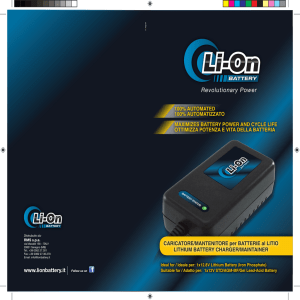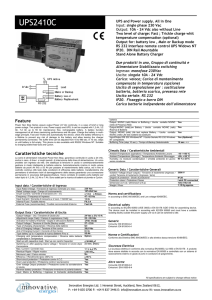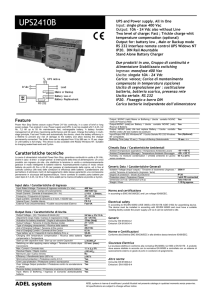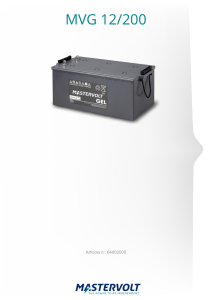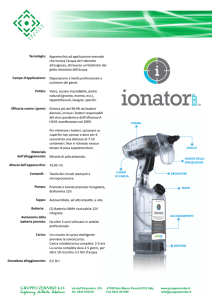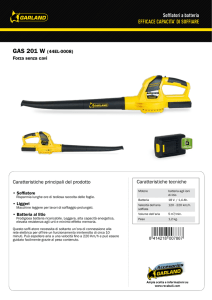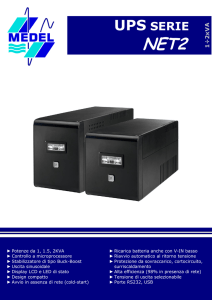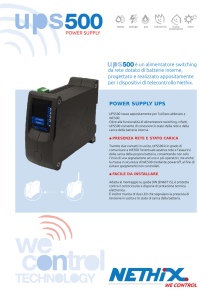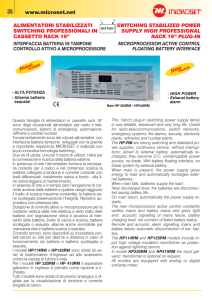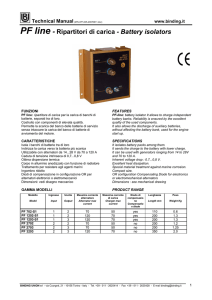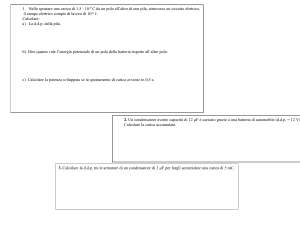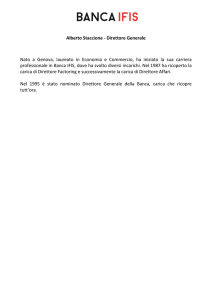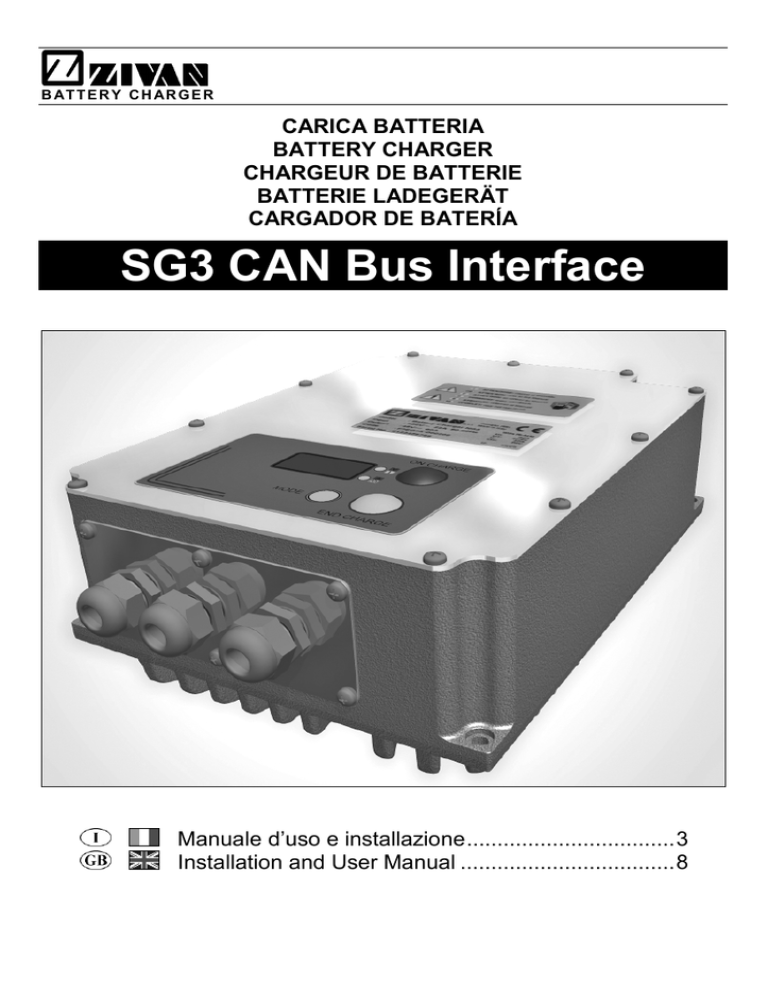
B AT T E R Y C H AR G E R
CARICA BATTERIA
BATTERY CHARGER
CHARGEUR DE BATTERIE
BATTERIE LADEGERÄT
CARGADOR DE BATERÍA
SG3 CAN Bus Interface
Manuale d’uso e installazione .................................. 3
Installation and User Manual ................................... 8
SG3 CAN Bus Interface
Mechanical dimension
86.0
116.0
140.0
220.0
290.0
323.2
N.B. All dimensions are expressed in mm
Drilling details
273.5
=
=
203.5
=
N.B. All dimensions are expressed in mm
2
D01911-02
Italiano
SG3 CAN Bus Interface
A T T E N Z I O N E Non rimuovere
il coperchio: pericolo di scosse elettriche.
Rivolgersi solo a personale autorizzato.
Scollegare l’alimentazione prima di collegare
o scollegare le connessioni alla batteria
Prima dell’utilizzo, leggere attentamente
il libretto di istruzioni. Verificare che
la curva di carica selezionata sia adatta al
tipo di batteria che si deve ricaricare.
Spiegazione dei simboli grafici:
Il simbolo di freccia a forma di fulmine all’interno di un triangolo equilatero avverte l’utente della presenza di “tensione
pericolosa” non isolata dentro il contenitore del prodotto; questa può essere di ampiezza sufficientemente grande per
costituire un rischio di scosse elettriche per le persone.
Il punto esclamativo all’interno di un triangolo equilatero avverte l’utente della presenza di importanti istruzioni d’uso e
manutenzione (servizio) contenute nella documentazione allegata al prodotto.
Questa apparecchiatura è coperta da garanzia.
Il relativo certificato di garanzia si trova allegato al libretto di istruzioni.
Se dovesse mancare, richiedetelo al vostro rivenditore.
Per futuri riferimenti, riportate nell’apposito spazio il numero di matricola:
Serial No. _____________________________
Le informazioni contenute in questo manuale sono di proprietà della ZIVAN S.r.l. che si riserva di fornirle ad uso esclusivo dei propri clienti.
Nessun altro uso è permesso senza un’autorizzazione scritta emessa dalla ZIVAN S.r.l..
La ZIVAN S.r.l. non risponde delle possibili inesattezze, imputabili a errori di stampa o di trascrizione, contenute nel presente manuale.
Si riserva di apportare ai propri prodotti quelle modifiche che ritenesse necessarie o utili, anche nell’interesse dell’utenza, senza
pregiudicare le caratteristiche essenziali di funzionalità e sicurezza.
Installazione e istruzioni di sicurezza
Il carica batteria SG3 è stato progettato per garantire sicurezza e prestazioni affidabili. Tuttavia, onde evitare danni alla propria persona e al
carica batteria, si raccomanda di osservare le seguenti precauzioni di base:
•
Leggere attentamente le istruzioni sull’installazione contenute in questo manuale. Per futuri riferimenti, riporre il manuale in un posto
sicuro.
•
Non posizionare il carica batteria nei pressi di fonti di calore.
•
Essendo il caricabatteria sigillato e privo di ventilazione forzata, le prestazioni dipendono dalla temperatura e dal tipo di installazione.
Quindi si consiglia l’installazione su piastra dissipante o analoga soluzione. Per aumentare la dissipazione termica è possibile
aggiungere dissipatori esterni eventualmente anche ventilati.
•
Verificare che il tipo di alimentazione a disposizione corrisponda al voltaggio previsto e indicato nella targhetta del carica batteria. In
caso di dubbio, consultare il proprio rivenditore o la società elettrica locale.
•
Come dispositivo di protezione nell’alimentazione del caricabatteria può essere utilizzato un interruttore differenziale di classe AC, ma
si consiglia l’utilizzo di uno di classe A o ancora meglio uno di classe B.
•
Come dispositivo di sicurezza e di compatibilità elettromagnetica, il carica batteria dispone di una spina a tre poli con messa a terra
che può essere inserita soltanto in una presa con messa a terra. Nel caso in cui non sia possibile inserire la spina nella presa, è molto
probabile che la presa a disposizione sia di un tipo vecchio e non a terra. In tal caso, contattare un elettricista per far sostituire la presa.
Si raccomanda di non usare un adattatore per risolvere il problema della messa a terra.
•
Evitare che il cavo di alimentazione sia in una posizione di ingombro. Nel caso in cui il cavo diventi logoro o subisca danni, farlo
sostituire immediatamente.
•
Nel caso in cui si usi una prolunga o una presa multipla, verificare che queste supportino il totale della corrente richiesta.
•
Scollegare l’alimentazione prima di collegare o scollegare le connessioni alla batteria.
•
Per la ricarica di batterie al Piombo: ATTENZIONE: Gas esplosivi - Evitare la formazione di fiamme e scintille. - La batteria deve essere
posizionata in un luogo ben ventilato.
•
Non utilizzare per ricarica di batterie per avviamento installate a bordo di automobili a motore termico.
•
Evitare di ricaricare batterie non ricaricabili.
•
Verificare che la tensione nominale della batteria da ricaricare corrisponda a quella indicata nella targhetta del carica batteria.
•
Verificare che la curva di carica selezionata sia adatta al tipo di batteria che si deve ricaricare. In caso di dubbio, consultare il proprio
rivenditore. La ZIVAN S.r.l. declina ogni responsabilità nel caso di errore nella scelta della curva di carica che porti a un
danneggiamento irreversibile della batteria.
•
Per evitare cadute di tensione e così garantire la carica completa della batteria, i cavi di uscita devono essere più corti possibile e di
sezione adeguata alla corrente di uscita.
•
Nel caso di compensazione termica della tensione di batteria, posizionare la sonda termica nel punto più caldo del vano batterie.
•
Non tentare di effettuare riparazioni sul carica batteria. L’apertura del coperchio potrebbe esporvi al rischio di scosse elettriche.
•
Non aprire il caricabatteria, l’apertura potrebbe portare a una perdita del grado di protezione (IP) che permarrebbe anche dopo aver
ripristinato le chiusure.
•
Nell’eventualità che il carica batteria non funzioni in modo corretto o che sia danneggiato, scollegarlo immediatamente dalla presa di
corrente e dalla presa di batteria e contattare il rivenditore.
D01911-02
3
SG3 CAN Bus Interface
Italiano
Attenzione
•
•
•
•
Il presente manuale è parte integrante del prodotto.
È vietato modificare o manomettere il prodotto.
Non usare per scopi diversi da quelli previsti.
I cavi di uscita devono terminare in un connettore idoneo al collegamento con il carico e protetto in modo da evitare contatti accidentali
con cavi in tensione.
Visualizzazioni
Strumento Digitale (versione con display)
Sullo strumento digitale vengono visualizzati, in sequenza, tali parametri:
•
•
•
•
TENSIONE sulla batteria (led bicolore rosso in alto).
CORRENTE erogata dal CB (led bicolore rosso in basso).
TEMPO in ore mancante alla fine della carica (led bicolore verde in alto).
Ah erogati (led bicolore verde in basso).
Premendo una volta il pulsante MODE, la sequenza dei parametri si blocca: il display mantiene l’ultima visualizzazione. Premendo ancora
una volta il pulsante MODE, riprende la sequenza dei parametri.
Indicatori BIG-LED (versione con display)
Colore
Descrizione
Rosso fisso
Fase a corrente massima (IUIa) o Allarme
Rosso lampeggiante (4s ON – 1s OFF)
Fase a controllo di tensione (IUIa).
Rosso fisso e Verde lampeggiante (4s ON – 1s OFF)
Fase finale di sovraccarica (IUIa).
Verde lampeggiante (4s ON – 1s OFF)
Fase attesa equalizzazione (IUIa).
Verde fisso
Carica terminata. (Solo per CU1 BA2)
Verde lampeggiante (4s ON – 1s OFF)
Impulso di equalizzazione e mantenimento.
Verde-Rosso lampeggianti
Collegamento con CanConsolle e S/S HW-SW.
Indicatore LED BICOLORE (versione senza display)
Colore
Descrizione
Rosso
Fase a corrente massima (IUIa).
Rosso lampeggiante (4s ON – 1s OFF)
Fase a controllo di tensione (IUIa).
Arancione
Fase finale di sovraccarica (IUIa).
Verde lampeggiante (4s ON – 1s OFF)
Fase attesa equalizzazione (IUIa).
Arancione lampeggiante (1s ON – 1s OFF)
Allarme.
Verde
Carica terminata.
Verde lampeggiante (4s ON – 1s OFF)
Impulso di equalizzazione e mantenimento.
Verde-Rosso alternati
Collegamento con CanConsolle e S/S HW-SW.
4
D01911-02
Italiano
SG3 CAN Bus Interface
Selezione Curve di Carica (versione con Display)
Il tasto MODE può essere premuto in due modalità:
1.
Pressione lunga (almeno 1 secondo): durante la programmazione del CB, ha il significato di ENTER;
2.
Pressione breve (meno di 1 secondo): durante la programmazione del CB, ha il significato di ROLL.
Programmazione:
1.
2.
3.
4.
5.
6.
7.
8.
9.
10.
Accendere il CB con il pulsante MODE premuto.
ROLL: selezione della tipologia del Nodo:
• da 1 a 19 indica un caricabatterie di tipo STAND-ALONE.
ENTER: conferma della tipologia del Nodo: si passa al livello per la scelta della Curva di carica.
ROLL: selezione della Curva di carica desiderata.
Sono disponibili 3 tipologie di curva di carica:
a.
CU1: curva IUIa più equalizzazione e mantenimento nel weekend;
b.
CU2: curva IU1U2ob;
c.
CU3: Generatore;
ENTER: conferma della Curva di carica: si passa alla scelta del Tipo di batteria (tipo Pb-Acid con comparsa della dicitura BA1, PbGel con comparsa della dicitura BA2 o Ion-Li con comparsa della dicitura BA3). La selezione BA3 è disponibile solo se è stato
precedentemente selezionato CU3.
ENTER: conferma del Tipo di batteria: si passa alla scelta della Capacità (solo per CU1 e CU2).
ROLL: selezione della Capacità.
Si parte da un valore nominale e tramite il ROLL si sceglie un valore compreso tra il 50% e il 140% del nominale a passi del 10%. Sul
display viene visualizzata la capacità in quel momento scelta.
ENTER: conferma della Capacità: si passa alla scelta del Tempo di carica (in ore).
ROLL: selezione del Tempo di carica.
Si parte da un Tempo di carica consigliato (funzione della capacità scelta al livello precedente): questo tempo può essere solo
aumentato fino ad un massimo di 20 ore.
ENTER: conferma del Tempo di carica: il CB si porta in una modalità stand-by in attesa che i cavi di uscita vengano collegati ai
morsetti di batteria (se questi sono stati collegati prima di iniziare la programmazione, terminato il punto 10 il CB parte
immediatamente).
Attenzione: nel caso venga effettuato un errore in un qualsiasi punto della programmazione, spegnere il caricabatterie e riaccenderlo con il
pulsante MODE premuto, quindi ripetere dall’inizio i punti della programmazione.
Programmazione compensazione caduta di tensione sui cavi di uscita (versione con Display).
Durante la carica, premendo a lungo il pulsante MODE, è possibile entrare nel menù di programmazione della compensazione di caduta sui
cavi. Eseguire le operazioni sotto elencate quando il caricabatteria eroga la massima corrente.
1.
Considerando la massima corrente del caricabatteria, la sezione e la lunghezza dei cavi( cavo positivo più cavo negativo), stimare la
caduta di tensione sui cavi.
2.
Premere brevemente il pulsante MODE (ROLL) finché non si raggiunge il valore di tensione più prossimo a quello desiderato: è
possibile fare il ROLL dei parametri tra 0,0V e 1,5V a passi di 0,1V.
3.
Premere a lungo il pulsante MODE (ENTER) per confermare.
Curva di Carica (versioni senza display)
Nel caricabatteria è presente una unica curva di carica di tipo IUIa più equalizzazione e mantenimento (salvo diversa indicazione nel foglio
curva di carica allegato al caricabatteria), programmabile tramite protocollo CANBUS. Per i valori standard di carica si veda il foglio allegato
al caricabatteria.
Connessioni
OUT
AUX
IN
D01911-02
5
SG3 CAN Bus Interface
Italiano
Cavi ingresso e uscita
INPUT: cavo multipolare 3x2.5mm².
OUTPUT (correnti fino a 25A): cavo Flex 6mm² (cavo positivo color rosso, cavo negativo color nero).
OUTPUT (correnti fino a 50A): cavo Flex 10mm²(cavo positivo color rosso, cavo negativo color nero).
OUTPUT (correnti fino a 80A): cavo Flex 16mm²(cavo positivo color rosso, cavo negativo color nero).
OUTPUT (correnti fino a 100A): cavo Flex 25mm²(cavo positivo color rosso, cavo negativo color nero).
Cavo ingressi e uscite AUX
PIN
1
2
3
4
5
6
Connettore super seal 6 vie FE
Colore filo
Descrizione
Bianco
AUX1 COM
Marrone
AUX1 NO
Viola
AUX1 NC
Grigio
AUX2 COM
Rosa
AUX2 NO
Rosso/Blu
AUX2 NC
PIN
1
2
3
4
5
Connettore super seal 5 vie MA
Colore filo
Descrizione
Grigio/Rosa
Sonda termica PT100
Bianco/Giallo
Sonda termica NPT100
Giallo/Marrone
Led Remodo COM
Bianco/Grigio
Led Remoto Verde
Grigio/Marrone
Led remoto Rosso
PIN
1
2
3
4
5
Connettore supe-seal 5 vie FE
Colore filo
Descrizione
Blu
CAN NEG
Giallo
CAN H
Verde
CAN L
Marrone / Verde
CAN L
CAN HT: resistenza di terminazione da
Bianco / Verde
120Ω connessa internamente a CAN H
Allarmi (versione con display)
Quando si verifica una situazione di allarme che comporta il blocco della carica, sullo strumento digitale viene visualizzata l’informazione
corrispondente secondo la seguente codifica:
<A> <codice allarme espresso con 2 cifre>
La codifica degli allarmi è indicata nella tabella che segue:
CODICE
A01
A02
A03
A05
A07
A08
A09
A10
A13
A14
A15
A16
A17
A18
A23
A24
A25
A26
A27
A28
A29
TIPO DI ALLARME
LOGIC FAILURE #1
CAN BUS KO
WATCHDOG
HIGH BATTERY TEMPERATURE
OVERCURRENT
HIGH TEMPERATURE
MISMATCH VOLTAGE
TIMEOUT
BATTERY DISCONNECTED
PUMP PRESSURE ERROR
THERMAL SENSOR FAILURE
LOGIC FAILURE #2
FLASH CHECKSUM
EEPROM KO
POWER FAILURE #1
WRONG INPUT MAINS
SHORT OUTPUT
WRONG MARKER EEP
NO MAINS
LOW TEMPERATURE
CLOCK BATTERY OFF
DESCRIZIONE
Problema nella lettura della corrente
Problema di comunicazione CAN
Malfunzionamento nella logica
Temperatura batteria superiore ai 55°C
Sovracorrente
Temperatura alta del caricabatteria
Errore nella lettura della tensione di batteria
Fase 1 finita per timeout
Batteria disconnessa
Pressione Pompa errata.
Assenza o guasto della sonda termica
Mancanza alimentazione Logica
Flash del microcontrollore corrotta
Memoria EEPROM/Flash corrotta
Guasto sul circuito di misura della corrente di batteria
Tensione di alimentazione esterna al range di funzionamento
Cortocircuito in uscita
Memoria EEPROM/Flash corrotta
Assenza rete di alimentazione
Temperatura interna inferiore a -30°C
Batteria clock calendar scarica o scollegata
BLOCCO CB
Si
No
Si
Temporaneo
Temporaneo
Temporaneo
Temporaneo
Si
Temporaneo
No
No
Temporaneo
SI
SI
SI
SI
SI
SI
Temporaneo
Temporaneo
No
Note:
A05:
6
la carica riparte quando la temperatura di batteria si porta ad un valore inferiore ai 45°C.
D01911-02
Italiano
CARATTERISTICHE TECNICHE
SG3 CAN Bus Interface
Ta=25°C se non diversamente specificato.
Morsetti di Alimentazione
Descrizione
Tensione di Alimentazione monofase
Frequenza
Corrente Massima assorbita per fase*
Picco iniziale di corrente
(Inrush current)
Fattore di Potenza
Simbolo
Vin
f
Ifmax
-
Condizioni di Test
-
Valore e/o Range
110 - 230 ± 10%
50 ÷ 60
15
Unità
Veff
Hz
Aeff
Vin=230Veff
<3
A
P = Pmax, Vin = 230eff
-
Pinmin
P = Pmax
Carica terminata - Standby
0,98
Potenza Minima assorbita
<5
W
Potenza Massima assorbita
Pinmax
P = Pmax
3.3
kW
cosϕ
* Valore massimo per modello. Per l’effettiva corrente assorbita fare riferimento ai valori di targa.
Morsetti di Batteria
Descrizione
Corrente di uscita
Corrente Massima di uscita
Ondulazione della corrente di uscita
Corrente assorbita
Tensione di uscita
Tensione Costante di uscita
Compensazione Termica della Tensione di uscita
Range di funzionamento della Sonda Termica
Ondulazione della tensione di uscita
Potenza Massima fornita
Capacità di uscita
Simbolo
I
I1
Ia
U
U1
dU1/dT
∆T
Pmax
C
Condizioni di Test
Fase 1
I = I1
Apparecchiatura spenta
Sui morsetti di OUT con I = 90% di I1
Fase 2
U = U1
U = U1, I = I1
-
Valore e/o Range
Vedi curva ± 5%
Vedi curva ± 5%
< 5%
< 0,5
Unità
A
ACrms
mA
Vedi curva ± 0,5%
Vedi curva ± 0,5%
V
Programmabile mV/(°C·el)
(-1÷-9), default -5
da -20 a +55
°C
< 1%
3000
W
Dipende dal
modello (>0,2)
mF
Generali
Descrizione
Range termico di funzionamento
Umidità relativa massima
Rendimento
Dimensioni massime
Peso
Tipo di protezione
Caratteristiche contatti ausiliari AUX1 e AUX2
Simbolo
∆T
RH
η
a×b×c
-
Condizioni di Test
Ogni condizione di funzionamento
Senza cavi di collegamento
Senza cavi di collegamento
-
Valore e/o Range
da -20 a +50
90%
≥90%
316×220×94,2
IP55
4
Unità
°C
mm
kg
A
Descrizione
Isolamento
Isolamento
Isolamento
Corrente di dispersione (leakage) (Filtro EMC)
Simbolo
IL
Condizioni di Test
Morsetti di Alimentazione e di Batteria
Morsetti di Alimentazione e Terra
Morsetti di Batteria e Terra
Apparecchiatura alimentata
Valore e/o Range
1250
1250
1250
<7
Unità
VAC
VAC
VAC
mA
Fusibili di ingresso
Fusibile di uscita
Tensione Minima di uscita per il funzionamento
(Sensore di Batteria)
Tensione Massima di uscita
Inversione di polarità in uscita
F1
F5
-
Interno all’apparecchiatura
Interno all’apparecchiatura
All’accensione dell’apparecchiatura
20
Circa 1.5 x I1
Vedi Curva
A
A
V / el
Um
-
Fase 3 (IUIa - IUIUo)
Messa in funzione
V
-
-
Vedi Curva
Protezione data dal
fusibile di uscita
100
°C
-
-
-
Protezioni e Sicurezza
Protezione Termica dei semiconduttori
(Temperatura di Allarme Termico)
Prescrizioni (norme) di Sicurezza
Prescrizioni (norme) EMC
D01911-02
7
SG3 CAN Bus Interface
English
A T T E N T I O N : To reduce the risk of
electric shock, do not remove cover.
Refer servicing to qualified service personnel.
Disconnect the mains supply before connecting
or disconnecting the links to the battery.
Read the Instruction Manual carefully
before use. Verify that the selected
charge curve is suitable for the type
of battery You have to re-charge.
Explanation of Graphical Symbols:
The lightning flash with arrowhead symbol, within an equilateral triangle, is intended to alert the user to the presence of
uninsulated “dangerous voltage” within the equipment’s enclosure; that may be of sufficient magnitude to constitute a risk of
electric shock to persons.
The exclamation point within an equilateral triangle is intended to alert the user to the presence of important operating and
maintenance (servicing) instructions in the literature accompanying the equipment.
This product is covered by warranty.
The relative warranty certificate is attached to the Instructions Manual.
If the Manual is not provided with this certificate, please ask your retailer for a copy.
For further references, please write the serial number in the proper space:
Serial No. _____________________________
Information contained in this Manual relates to ZIVAN S.r.l. property which reserves the right to supply for the exclusive use of customers.
No other use is allowed without a written authorization supplied by ZIVAN S.r.l.
ZIVAN S.r.l. will be not responsible for inaccuracies contained in this manual due to print or translation errors. ZIVAN S.r.l. has the right to
make changes or improvements, also for the user interest, without prejudicing the essential characteristic of operation and safety.
Installation and safety instructions
Battery charger SG3 plus has been designed to provide safety and reliable. It is necessary to observe the following precautions in order to
avoid damage to persons and to the battery charger:
•
Read the installation instructions contained in this Manual carefully. For further information put the Manual in a proper place.
•
Do not put the battery charger near heat sources.
•
Being a sealed charger with no force-ventilation, its performances depend on the temperature and on the kind of installation. It is kindly
recommended to install it on a dissipating plate or similar. External heatsink, even ventilated, can be mounted in order to increase the
thermal dissipation.
•
Verify that the available supply voltage corresponds to the voltage that is stated on the battery charger name plate. In case of doubt,
consult a retailer or local Electric Supply Authority.
•
As protection device in the input of the battery charger You can both use a switch of AC class, but it is warmly recommended to use
one of A class or even better one of B class.
•
For safety and electromagnetic compatibility, the battery charger has a 3-prong plug as a safety feature, and it will only fit into an
earthed outlet. If you can not plug it in, chances are you have an older, non-earthed outlet; contact an electrician to have the outlet
replaced. Do not use an adapter to defeat the grounding.
•
To avoid damaging the power cord, do not put anything on it or place it where it will be walked on. If the cord becomes damaged or
frayed, have it immediately replaced.
•
If you are using an extension cord or power strip, make sure that the total of the amperes required by all the equipment on the
extension is less than the extension’s rating.
•
Disconnect the mains supply before connecting or disconnecting the links to the battery.
•
To recharge Lead Acid batteries: WARNING: Explosive Gas – Avoid flames and sparks. The battery must be positioned in a correctly
cooled place.
•
Do not use to charge starting batteries put on board of thermal engine cars.
•
Avoid recharging of non-rechargeable batteries.
•
Verify that the nominal voltage of the battery to be re-charged corresponds to the voltage stated on the battery charger name plate.
•
Verify that the selected charging curve is suitable for the type of battery to be re-charged. In case of doubt, consult Your retailer. ZIVAN
S.r.l. will not accept any responsibility in case of mistaken choice of the charging curve that may cause irreversible damage to the
battery.
•
In order to avoid voltage drop, thereby assuring 100% charge at the battery, the output cables must be as short as possible, and the
diameter must be adequate for the output current.
•
In case of thermal compensation of the battery voltage, put the thermal sensor in the warmest point inside the battery compartment.
•
Do not try to service the battery charger yourself. Opening the cover may expose you to shocks or other hazards.
•
Do not open the charger. Opening it may bring to a loss in the protection grade (IP), that may persist also after having restored the
sealing.
•
If the battery charger does not work correctly or if it has been damaged, unplugged it immediately from the supply socket and from the
battery socket and contact a retailer.
8
D01911-02
English
SG3 CAN Bus Interface
Warning
•
•
•
•
This user manual must be intended as part of the product.
Do not make any modification to the product.
Do not use for any different purposes.
In order to guarantee the suitable protection against accidental contact to live parts, a proper connector must be installed on the output
Cables
An overcurrent protection device must be installed at the unit output, see electric feature section for its ratings.
•
Visualization
Digital instrument (display version)
From the starting the digital instrument will display the string of the following parameters:
•
•
•
•
BATTERY VOLTAGE (two-tone red upper led).
CURRENT provided by the charger (two-tone red lower led).
TIME in hours lacking to the end of charge (two-tone green upper led).
Ah supplied (two-tone green lower led).
By pressing the MODE button, the parameters’ sequence is blocked and it will be kept the last value displayed. By pressing again on the
MODE button the sequence of parameters restarts.
BIG LED indicators (display version)
Colour
Red
Description
Constant or Max current phase (IUIa).
Blinking red (4s ON – 1s OFF)
Voltage control phase (IUIa).
Red and blinking green (4s ON – 1s OFF)
Overcharging phase (IUIa).
Blinking green (4s ON – 1s OFF)
Wait phase (for equalization) (IUIa).
Green
End charge (only for CU1 BA2)
Blinking green (4s ON – 1s OFF)
Equalization pulse and floating
Green and red blinking together
Connection with CanConsolle or S/S HW-SW.
BI-COLOR LED indicator (version without display)
Colour
Description
Red
Constant or Max current phase (IUIa).
Blinking red (4s ON – 1s OFF)
Voltage control phase (IUIa).
Orange
Overcharging phase (IUIa).
Blinking green (4s ON – 1s OFF)
Wait phase (for equalization) (IUIa).
Blinking Orange (1s ON – 1s OFF)
Allarm.
Green
End charge
Blinking green (4s ON – 1s OFF)
Equalization pulse and floating
Green red alternated
Connection with CanConsolle or S/S HW-SW.
D01911-02
9
SG3 CAN Bus Interface
English
Charging curve selection (display version)
You can press the MODE button according two modalities:
1.
Long pressure (at least 1 second): along the battery charger setting it means ENTER
2.
Short pressure (less than 1 second): along the battery charger setting it means ROLL.
Setting:
1.
2.
3.
4.
5.
6.
7.
8.
9.
10.
While pressing the MODE button light on the equipment.
ROLL: select the node type:
• from 1 to 19 identifies a STAND-ALONE charger.
ENTER: node type confirmation. Next selection is to choose the Charging Curve.
ROLL: select the desired Charging curve.
There are 3 available charging curves:
a.
CU1: IUIa curve plus equalization and maintenance;
b.
CU2: IU1U2ob curve;
c.
CU3: power supply;
ENTER: Charging curve confirmation. Next selection is to choose the Battery type. (Lead acid type corresponds to BA1, Gel
corresponds to BA2, Ion-Li corresponds to BA3). The BA3 selection is available only if CU3 has been previously selected.
ENTER: Battery type confirmation: next level is to select the Capacity (only for CU1 and CU2).
ROLL: Capacity selection.
Starting point is a nominal value and by the ROLL you can select a value included between 50% and 140% of the nominal in steps of
10%. On the display it is shown the last capacity selected.
ENTER: Capacity confirmation: then you can select the Recharging time (in hours).
ROLL: Recharging time confirmed .
Starting from a suggested Recharging time (according to the capacity chosen at the previous step ) this time can only be increased
up to 20 hours max.
ENTER: Recharging time confirmation: the battery charger goes to a stand-by modality waiting that the output cables being
connected to the battery binding-clamps (if connections have been done already before starting the setting, once arrived at point 10
the charger immediately starts).
Warning: if some trouble or mistake may occur along setting procedure, switch off the battery charger, then switch it on again by keeping
pressed the MODE button and restart setting operation from the beginning.
Compensation setting of the voltage drop on output cables (display version)
While charging, with a long pressure of Mode Button, you can program the voltage cables drop. Execute the following operations while
charger is at maximum current.
1.
Knowing the size and length (positive plus negative lengths) of the output cables, compute the voltage drop at the maximum output
current.
2.
Press shortly the MODE button (ROLL) until reaching the nearest voltage value to the desired one: it is possible to ROLL parameters
between 0,0V e 1,5V with steps of 0,1V.
3.
Press long the MODE button (ENTER) to confirm.
Charging curve (version without display)
The charger is provided of only one charging curve, which is IUIa type and includes equalization and maintenance (unless differently
specified in the enclosed additional document, please read it to verify parameters.). The curve can be regulated through CANBUS protocol.
Connections
OUT
AUX
IN
10
D01911-02
English
SG3 CAN Bus Interface
Input and output cables
INPUT: multiwires cable 3x2.5mm².
OUTPUT (currents up to 25A): Flex cable 6mm² (red wire for the positive pole, black wire for the negative).
OUTPUT (currents up to 50A): Flex cable 10mm² (red wire for the positive pole, black wire for the negative).
OUTPUT (currents up to 80A): Flex cable 16mm² (red wire for the positive pole, black wire for the negative).
OUTPUT (currents up to 100A): Flex cable 25mm² (red wire for the positive pole, black wire for the negative).
Auxiliary inputs and outputs cable
Connettore super seal 6 vie FE
Colore filo
Descrizione
White
AUX1 COM
Brown
AUX1 NO
Violet
AUX1 NC
Grey
AUX2 COM
Pink
AUX2 NO
Red/Blue
AUX2 NC
PIN
1
2
3
4
5
6
PIN
1
2
3
4
5
Connettore super seal 5 vie MA
Colore filo
Descrizione
Grey/Pink
Thermal sensor PT100
White/Yellow
Thermal Sensor NPT100
Yellow/Brown
Remote Led COM
White/Grey
Remote Led Verde
Grey/Brown
Remote Led Rosso
PIN
1
2
3
4
5
Connettore supe-seal 5 vie FE
Colore filo
Descrizione
Blue
CAN NEG
Yellow
CAN H
Green
CAN L
Brown / Green
CAN L
CAN HT: 120Ω termination resistor
White/ Green
internally connected to CAN H
Alarms (display version)
When an alarm situation stopping the charge occurs, the display shows one of the information below according failure detected:
<A> <alarm code identified with a 2 digits code>
Alarm table list here following:
CODE
A01
A02
A03
A05
A07
A08
A09
A10
A13
A14
A15
A16
A17
A18
A23
A24
A25
A26
A27
A28
A29
ALARM TYPE
LOGIC FAILURE #1
CAN BUS KO
WATCHDOG
HIGH BATTERY TEMPERATURE
OVERCURRENT
HIGH TEMPERATURE
MISMATCH VOLTAGE
TIMEOUT
BATTERY DISCONNECTED
PUMP PRESSURE ERROR
THERMAL SENSOR FAILURE
LOGIC FAILURE #2
FLASH CHECKSUM
EEPROM CHECKSUM
POWER FAILURE #1
WRONG INPUT MAINS
SHORT OUTPUT
WRONG MARKER EEP
NO MAINS
LOW TEMPERATURE
CLOCK BATTERY OFF
DESCRIPTION
Trouble on current detection
Trouble on CAN communication
Logic board mis-working
Battery temperature higher than 55°C
Over current
Battery charter high temperature
Battery voltage sensing error
Phase 1 finished for timeout
Battery disconnected
Wrong Pump Pressure. Air pump working not properly
Thermal sensor not connected o failed
Logic supply failure
Microcontroller Flash memory corrupted
EEPROM/Flash memory corrupted
Output current sensing circuit damaged
Input mains level out of the operating range
Short circuit at the output stage
EEPROM/Flash memory corrupted
Input grid failure
Charger internal temperature below -30°C
Clock Calendar battery discharged or not connected
STOP
YES
No
YES
Temporary
Temporary
Temporary
Temporary
YES
Temporary
No
No
Temporary
YES
YES
YES
YES
YES
YES
Temporary
Temporary
No
Notes:
A05:
D01911-02
The charge restarts once the battery temperature reaches a value lower than 45°C.
11
SG3 CAN Bus Interface
English
TECHNICAL FEATURES
Ta=25°C unless otherwise specified
Mains side
Description
Supply Voltage
Frequency
Absorbed Maximum Current per phase. *
Symbol
Vin
f
Ifmax
Test Condition
-
Value and/or Range
110 - 230 ± 10%
50 ÷ 60
15
Unit
Veff
Hz
Aeff
P = Pmax
Inrush Current
Power Factor
Absorbed Minimum Power
cosϕ
Pinmin
Vin=230Veff
P = Pmax
End of charge - Standby
<3
0.98
A
-
Absorbed Maximum Power
Pinmax
<5
W
P = Pmax
3.3
kW
Value and/or Range
See curve ± 5%
See curve ± 5%
< 5%
< 0,5
Unit
A
mA
* Maximum value per model. For the effective current absorption please refer to the charger’s identification label.
Battery side
Description
Output current
Maximum output current
Output current ripple
Absorbed current
Symbol
I
I1
Ia
Output voltage
Constant output voltage
Thermal compensation of output voltage
U
U1
dU1/dT
Operating range of Temperature Sensor
Output voltage ripple
Maximum power supplied
∆T
Pmax
Output capacity
C
Test Condition
Phase 1
I = I1
Equipment turned off
See curve ± 0,5%
On the OUT clamps with I = 90% of I1
See curve ± 0,5%
V
Phase 2
Programmable (-1÷-9), mV/(°C·cell)
default -5
from -20 to +55
°C
U = U1
< 1%
U = U1, I = I1
3000
W
-
Depend on the model
(>0,2)
mF
General
Description
Operating range of temperature
Maximum relative humidity
Efficiency
Maximum size
Weight
Enclosure class
AUX1 and AUX2 contact ratings
Symbol
∆T
RH
η
a×b×c
-
Test Condition
At each operation condition
Without connecting cable
Without connecting cable
-
Value and/or Range
from -20 to +50
90%
≥90%
316×220×94,2
6.2
IP55
4
Unit
°C
mm
kg
A
Symbol
IL
Test Condition
Mains to Battery side
Mains side to Earth
Battery side to Earth
Supplied equipment
Value and/or Range
1250
1250
1250
<7
Unit
VAC
VAC
VAC
mA
20
About 1.5 x I1
See curve
A
A
V/cell
V
-
-
See curve
Protection provided by
the output fuse
100
°C
-
-
-
Protection and Safety
Description
Insulation
Insulation
Insulation
Leakage current (EMC Filter)
Input fuses
Output fuse
Minimum output voltage of operation (Battery
Detector)
Maximum output voltage
Reverse output polarity
Thermal protection of semiconductors
(Temperature of Thermal Alarm)
Safety Requirements (Rules)
EMC Requirements (Rules)
12
F1
F5
-
Inside the equipment
Inside the equipment
Equipment turn on
Um
-
Phase 3 (IUIa - IUIUo)
At the connection to the Battery
D01911-02
Italiano
SG3 CAN Bus Interface
Progettazione, produzione e vendita:
ZIVAN SRL
Via Bertona, 63/1
42028 Poviglio (RE) ITALIA
Tel. +39 0522 960593
Fax +39 0522 967417
[email protected]
www.zivan.it
UFFICI VENDITA
AUSTRALIA
M+H Power Systems
9 Mosrael Place
Rowville, Victoria, 3178
TEL: +61 3 9763 0555
FAX: +61 3 9763 0577
[email protected]
www.mhpower.com.au
BELGIUM
BATTERY SUPPLIES NV
Lindestraat, 89A
8790 Waregem
Tel +32 56 617977
Fax +32 56 617955
[email protected]
www.batterysupplies.be
BRASIL
ZAPI DO BRASIL
Rua Euclides Savietto N&ordm; 6
Sala N&ordm; 5
Bairro Jardim Rina
Santo Andre - SP
Brasil Tel +55 (11) 4475 7334
Fax +55 (11) 4476 7740
[email protected]
www.zapidobrasil.com.br
CHILE
VARELEC CHILE LTDA
Calle Herrera, 972
Santiago
Tel e Fax +56 2 6826830
[email protected]
www.varelecchile.cl
CHINA
ZAPI SHANGHAI
Room 104-B, Building 2, 690 Bibo Road,
Zhang Jiang High-Tech Park
201203 Shanghai Cina
Tel: + 86 21 50272823
Fax: + 86 21 50270791
www.zapicn.com
[email protected]
DEUTSCHLAND
ATECH Antriebstechnik GmbH
Gewerbegebiet Hohenwart
Fuggerstrasse 30
D-84561 Mehring/Obb.
Tel +49 8677 98090
Fax +49 8677 980920
[email protected]
www.atech-antriebstechnik.de
ESPANA (SERVICE)
VARELEC S.L.
C/Lope de Vega 5-7 Bajos
08005 Barcelona
Tel +34 93 3032565
Fax +34 93 2660690
[email protected]
www.varelec.com
FRANCE
URMA SARL
Parc D’Affaires Silic
30, Rue du Morvan – BP 50503
94623 Rungis Cedex
Tel +33 1 45 60 94 77
Fax +33 1 46 75 08 71
[email protected]
NEW ZEALAND
M+H Power Systems
Unit B, 237 Bush Road
Albany, Auckland
TEL: +64 9 415 6615
FAX: +64 9 415 8160
[email protected]
www.mhpower.com.au
SOUTH KOREA
ZAPI KOREA
322 ho, Third Floor,
DeokSan Besttel 69-1, SangNam-Dong
Changwon-City, Gyeongsangnam-Do
Tel: + 82 70 7533 5402
Fax: + 82 55 266 5402
Mobile: + 82 10 5113 5402
[email protected]
SWEDEN
ETP KRAFTELEKTRONIK AB
Box 125 (Järnringen 15)
433 23 Partille
Tel +46 31 440715
Fax +46 31 449720
[email protected]
www.etpab.se
SWITZERLAND
ASMO GMBH
Glashütte 58
04229 Beinwil
Tel +41 61 7931988
Fax +41 61 7931989
[email protected]
www.asmokarts.com
UNITED KINGDOM
EZ ELECTROFIT ZAPI LTD
Unit 2 – Halesfield 17 – Telford
Shropshire TF74PW
Tel +44 1 952 582482
Fax +44 1 952 581377
[email protected]
www.electrofit-zapi.com
U.S.A.
U.S.A.
ELECTRIC CONVERSIONS
515 NORTH 10TH STREET
95814 Sacramento CA
Tel +1 916 441 4161
Fax +1 916 444 8190
www.zivanusa.com
ZAPI INC.
267 Hein Drive
27529 Garner NC
Tel: +1 919 7894588
Fax: +1 919 7894583
[email protected]
www.zapiinc.com
13
D01911-02
SG3 CAN Bus Interface
14
Italiano
D01911-02
Italiano
D01911-02
SG3 CAN Bus Interface
15
ZIVAN S.r.l.
Via Bertona, 63/1
42028 Poviglio (RE) ITALIA
Tel. +39 0522 960593
Fax +39 0522 967417
E-mail: [email protected]
Web: www.zivan.it
16
D01911-02

